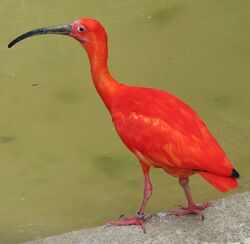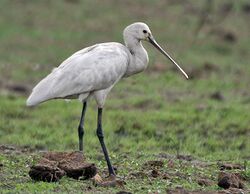Biology:Threskiornithidae
| Threskiornithidae | |
|---|---|

| |
| Scarlet ibis | |
| Scientific classification | |
| Domain: | Eukaryota |
| Kingdom: | Animalia |
| Phylum: | Chordata |
| Class: | Aves |
| Order: | Pelecaniformes |
| Suborder: | Ardei |
| Family: | Threskiornithidae Richmond, 1917 |
| Subfamilies | |
The family Threskiornithidae includes 36 species of large wading birds. The family has been traditionally classified into two subfamilies, the ibises and the spoonbills; however recent genetic studies have cast doubt on this arrangement, and have found the spoonbills to be nested within the Old World ibises, and the New World ibises as an early offshoot.
Taxonomy
The family Threskiornithidae was formerly known as Plataleidae. The spoonbills and ibises were once thought to be related to other groups of long-legged wading birds in the order Ciconiiformes. A recent study found that they are members of the order Pelecaniformes.[2] In response to these findings, the International Ornithological Congress (IOC) recently[when?] reclassified Threskiornithidae and their sister taxa Ardeidae under the order Pelecaniformes instead of the previous order of Ciconiiformes.[3] Whether the two subfamilies are reciprocally monophyletic is an open question. The South American Checklist Committee's entry for the Threskiornithidae includes the following comment "Two subfamilies are traditionally (e.g., Matheu & del Hoyo 1992) recognized: Threskiornithinae for ibises and Plataleinae for spoonbills; because the main distinction has to do with bill shape, additional information, especially genetic, is required to recognize a major, deep split in the family."[4]
A study of mitochondrial DNA of the spoonbills plus the sacred and scarlet ibises found that the spoonbills formed a clade with old world genus Threskiornis, with Nipponia nippon and Eudocimus as progressively earlier offshoots and more distant relatives, and hence casts doubt on the arrangement of the family into ibis and spoonbill subfamilies.[5] Subsequent studies have supported these findings, the spoonbills forming a monophyletic clade within the "widespread" clade of ibises, including Plegadis and Threskiornis, while the "new World Endemic" clade is formed by the genera restricted to the Americas such as Eudocimus and Theristicus.[6]
Description
Members of the family have long, broad wings with 11 primary feathers and about 20 secondaries. They are strong fliers and, rather surprisingly, given their size and weight, very capable soarers. The body tends to be elongated, the neck more so, with rather long legs. The bill is also long, decurved in the case of the ibises, straight and distinctively flattened in the spoonbills. They are large birds, but mid-sized by the standards of their order, ranging from the dwarf olive ibis (Bostrychia bocagei), at 45 cm (18 in) and 450 g (0.99 lb), to the giant ibis (Thaumatibis gigantea), at 100 cm (39 in) and 4.2 kg (9.3 lb).
Distribution and ecology
They are distributed almost worldwide, being found near almost any area of standing or slow-flowing fresh or brackish water. Ibises are also found in drier areas, including landfills.
The Llanos are notable in that these wetland plains support seven species of ibis in the one region.[7]
All ibises are diurnal; spending the day feeding on a wide range of invertebrates and small vertebrates: ibises by probing in soft earth or mud, spoonbills by swinging the bill from side to side in shallow water. At night, they roost in trees near water. They are gregarious, feeding, roosting, and flying together, often in formation.
Nesting is colonial in ibises, more often in small groups or singly in spoonbills, nearly always in trees overhanging water, but sometimes on islands or small islands in swamps. Generally, the female builds a large structure out of reeds and sticks brought by the male. Typical clutch size is two to five; hatching is asynchronic. Both sexes incubate in shifts, and after hatching feed the young by partial regurgitation. Two or three weeks after hatching, the young no longer need to be brooded continuously and may leave the nest, often forming creches but returning to be fed by the parents.
Species

FAMILY: THRESKIORNITHIDAE
- Subfamily: Threskiornithinae – Ibises
- Genus Threskiornis
- African sacred ibis, Threskiornis aethiopicus
- Malagasy sacred ibis, Threskiornis bernieri
- †Reunion ibis, Threskiornis solitarius (extinct)
- Black-headed ibis, Threskiornis melanocephalus
- Australian white ibis, Threskiornis molucca
- Solomons white ibis, Threskiornis molucca pygmaeus
- Straw-necked ibis, Threskiornis spinicollis
- Genus Pseudibis
- Red-naped ibis, Pseudibis papillosa
- White-shouldered ibis, Pseudibis davisoni
- Genus Thaumatibis
- Giant ibis, Thaumatibis gigantea
- Genus Geronticus
- Northern bald ibis, Geronticus eremita
- Southern bald ibis, Geronticus calvus
- Genus Nipponia
- Crested ibis, Nipponia nippon
- Genus Bostrychia
- Olive ibis, Bostrychia olivacea
- São Tomé ibis, Bostrychia bocagei
- Spot-breasted ibis, Bostrychia rara
- Hadada ibis, Bostrychia hagedash
- Wattled ibis, Bostrychia carunculata
- Genus Theristicus
- Plumbeous ibis, Theristicus caerulescens
- Buff-necked ibis, Theristicus caudatus
- Black-faced ibis, Theristicus melanopis
- Genus Cercibis
- Sharp-tailed ibis, Cercibis oxycerca
- Genus Mesembrinibis
- Green ibis, Mesembrinibis cayennensis
- Genus Phimosus
- Bare-faced ibis, Phimosus infuscatus
- Genus Eudocimus
- American white ibis, Eudocimus albus
- Scarlet ibis, Eudocimus ruber
- Genus Plegadis
- Glossy ibis, Plegadis falcinellus
- White-faced ibis, Plegadis chihi
- Puna ibis, Plegadis ridgwayi
- Genus Lophotibis
- Madagascar ibis, Lophotibis cristata
- Genus Threskiornis
- Subfamily: Plataleinae – Spoonbills
- Genus Platalea
- Eurasian spoonbill, Platalea leucorodia
- Black-faced spoonbill, Platalea minor
- African spoonbill, Platalea alba
- Royal spoonbill, Platalea regia
- Yellow-billed spoonbill, Platalea flavipes
- Roseate spoonbill, Platalea ajaja
- Genus Platalea
References
- ↑ Myers, P. R.; C. S. Parr. "Family Threskiornithidae (ibises and spoonbills)". Animal Diversity Web. University of Michigan. http://animaldiversity.ummz.umich.edu/site/accounts/classification/Threskiornithidae.html.
- ↑ Hackett, Shannon J.; Kimball, Rebecca T.; Reddy, Sushma; Bowie, Rauri C. K.; Braun, Edward L.; Braun, Michael J.; Chojnowski, Jena L.; Cox, W. Andrew et al. (June 2008). "A Phylogenomic Study of Birds Reveals Their Evolutionary History". Science 320 (5884): 1763–1768. doi:10.1126/science.1157704. PMID 18583609. Bibcode: 2008Sci...320.1763H.
- ↑ "Gill, F. & D. Donsker (Eds). 2010. IOC World Bird Names (version 2.4). Available at http://www.worldbirdnames.org/ [Accessed 29 May 2010].
- ↑ "A classification of the bird species of South America". South American Classification Committee. American Ornithologists' Union. http://www.museum.lsu.edu/~Remsen/SACCBaseline.htm.
- ↑ Chesser, R.Terry; Yeung, Carol K.L.; Yao, Cheng-Te; Tians, Xiu-Hua; Li Shou-Hsien (2010). "Molecular phylogeny of the spoonbills (Aves: Threskiornithidae) based on mitochondrial DNA". Zootaxa 2603 (2603): 53–60. doi:10.11646/zootaxa.2603.1.2. ISSN 1175-5326.
- ↑ J.L. Ramirez; C.Y. Miyaki; S.N. Del Lama (2013). "Molecular phylogeny of Threskiornithidae (Aves: Pelecaniformes) based on nuclear and mitochondrial DNA". Genetics and Molecular Research 12 (3): 2740–2750. doi:10.4238/2013.July.30.11. PMID 23979898.
- ↑ Frederick, Peter C.; Bildstein, Keith L.. "Foraging Ecology of Seven Species of Neotropical Ibises (Threskiornithidae) during the Dry Season in the Llanos of Venezuela". The Wilson Bulletin 104 (1): 1–21.
External links
- Threskiornithidae videos on the Internet Bird Collection
Wikidata ☰ Q162085 entry
 |


